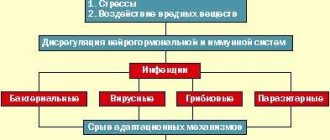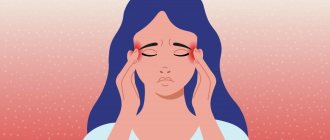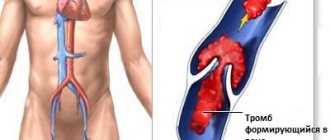Causes and diagnosis of pain in the groin area in women. The groin area occupies the lower abdominal cavity. Any sensations of discomfort in this part of the body are signs of various diseases in the body. The pain can be localized on both sides of the groin and be sharp, aching or throbbing.
Since there are a large number of organs in the groin area, pain can be caused by various types of inflammatory processes or other dysfunctions. If you experience pain of any intensity, you should definitely consult a doctor.
Causes of groin pain
There can be many causes of groin pain.
- Hernia.
One of the reasons is an inguinal hernia, the symptoms of which slowly increase, and it all starts with a small area, the area of which gradually grows. The only way to cure an inguinal hernia is surgical removal. - Injuries.
Athletes are often at risk for groin pain caused by adductor tears, rectus femoris tears, or acetabular injuries. - Inflammation of the joints and spine.
In addition, all kinds of complaints about the spine, as well as inflammation or degeneration of the hip joint, can cause discomfort in this part of the body. - Infections.
Enlarged lymph nodes due to a urinary tract infection or sexually transmitted infection can also lead to groin pain.
There are also a number of other ailments in which you can expect groin pain. This could be femoral nerve neuropathy, appendicitis, or urolithiasis.
Appendicitis
Diagnosis and treatment of groin pain
If you experience even minor pain, you should consult a doctor. Depending on the disease, a woman may need to consult a surgeon, therapist, urologist, gynecologist, or oncologist.
Diagnosis of the disease includes:
- examination and questioning of the patient’s complaints;
- carrying out laboratory tests (blood test, urine test, cytology smears, stool test for occult blood);
- instrumental studies (colposcopy, ultrasound of the pelvic organs, cytoscopy, colonoscopy).
Treatment is prescribed depending on the disease. In the presence of inflammatory processes, drug therapy (anti-inflammatory drugs, antibiotics, painkillers and hormonal agents) and physiotherapy (UHF, magnetic therapy) are necessary.
Appendicitis, ectopic pregnancy, and cyst rupture require surgical intervention. Surgical treatment is also recommended in cases where drug therapy does not produce positive results.
Gynecological diseases causing groin pain in men
In men, groin pain can cause varicose veins in this area. Testicular varicose veins occur most often in young men. Symptoms of the pathology intensify with prolonged standing, walking and during an erection.
In addition, all kinds of injuries to the scrotum and inflammation of the testicles can cause pain in the groin.
If pain in the groin is accompanied by swelling of the scrotum and temperature, you should consult a doctor as soon as possible! This could be a symptom of testicular torsion!
Classification of pain in the perineum
The identification of different groups, categories or classes of pain symptoms occurring in the groin is based on various parameters. All of them are presented in our table below.
| Type of pain | Distinctive features |
| Classification based on predisposing factor | |
| Primary | Develops as a result of a perineal injury or due to a neurological disorder. |
| Secondary | Pain radiating to the perineum due to existing diseases of the internal organs. |
| Classification by origin | |
| Visceral | It occurs due to compression or irritation of the nerves located in the organs of the genitourinary system. |
| Neurogenic | Occurs due to damage to nerve tissue in the perineal area. |
| Psychogenic | It occurs as a result of disturbances in the patient’s psycho-emotional state due to stress, depression, and neuroses. |
| Classification by duration of manifestation | |
| Acute | It appears brightly and lasts for a short time: from a couple of minutes to several hours, but not more than 24 hours. |
| Chronic | It is mild and lasts for a long time: several months. |
| Classification by nature of manifestation | |
| Pulling | Such painful symptoms are characterized by duration and often intensify in a sitting position or during defecation. It is typical for the postpartum period and occurs due to swelling and sprains, and also develops with the following diseases:
|
| Sharp, sharp | It is typical for any perineal injuries, ranging from ordinary bruises to muscle ruptures. It is very intense and can even cause loss of consciousness. It may also occur with diseases such as:
|
| Bursting | Most often it occurs in women before childbirth, when the body is preparing for this process, as well as during inflammatory processes of the vaginal mucosa. |
Our doctors
Kochetov Sergey Anatolievich
Urologist, Candidate of Medical Sciences, doctor of the highest category
34 years of experience
Make an appointment
Khromov Danil Vladimirovich
Urologist, Candidate of Medical Sciences, doctor of the highest category
35 years of experience
Make an appointment
Perepechay Dmitry Leonidovich
Urologist, Candidate of Medical Sciences, doctor of the highest category
40 years of experience
Make an appointment
Mukhin Vitaly Borisovich
Urologist, Head of the Department of Urology, Candidate of Medical Sciences
34 years of experience
Make an appointment
Disturbances in the functioning of the urinary system
Cystitis is one of the most common causes of aching pain in women. The bladder can become inflamed after simple hypothermia. Pain when urinating, false and frequent urges are characteristic symptoms of this disease. Other frequently diagnosed pathologies of the urinary system include pyelonephritis and urethritis, in which case discomfort occurs not only in the lower abdomen, but also in the back (especially in the lumbar region).
If pain is dull in nature and occurs in the area above the pubis, bladder polyps can be assumed.
How do you find out the cause of pain? Diagnostics
A diagnostic search for the causes of pelvic pain is impossible without a thorough analysis of the woman’s complaints and medical history . Everything is important here: the nature (pulling, cutting, pressing, etc.) and localization of pain (in the middle, right, left, in the sacrum, rectum, bladder), its duration, in case of unstable pain - the frequency of its occurrence, connection with provoking factors (movement, body position, diet, urination, sexual contact).
the menstrual cycle (during menstruation, after, between menstruation, before it) and data on previous pregnancies or concomitant infertility is extremely important . Clarification of this connection often provides the key to understanding the causes of the disease. In addition, the doctor must know everything about the characteristics of the menstrual cycle and sex life of a woman, as well as about any sexually transmitted diseases and vaginal discharge.
Since pain is often associated with other organs, the doctor should ask in detail about the function of the intestines and urinary organs, concomitant diseases of the musculoskeletal system, and previous operations.
A general and gynecological examination is required . Already at this stage, it is possible to exclude the possibility of a major pelvic pathology (tumor), as well as establish the localization of painful sensations.
Based on the survey and examination, the doctor will be able to identify some types of pain syndromes, which significantly narrows and facilitates the further search for the cause. These syndromes include:
- Dyspareunia - painful sexual intercourse
- (Algo)dysmenorrhea - painful menstruation
- Ovulatory pain is cyclical pain in the middle of the menstrual cycle associated with ovulation.
- Pain in the vagina, external genitalia, and perineum (may be associated with infection, tumor, neuropathy, vulvodynia)
- Painful bladder (causes: infectious process, interstitial cystitis, bladder stones and tumors, consequences of previous surgeries)
- Pain associated with filling and bowel movement
- Neuropathies of the sciatic and pudendal nerves
Additional research.
The doctor takes vaginal and cervical discharge for analysis to rule out the possibility of an infectious disease. It is recommended to conduct a cytological examination of a scraping from the cervix. An ultrasound examination of the pelvic organs is always performed In some cases (suspicion of endometriosis of the recto-vaginal septum, retroperitoneal tumors, suspicion of pathology of the pelvic lymph nodes), magnetic resonance imaging .
Most patients with pelvic pain require diagnostic laparoscopy. Laparoscopy is the most useful minimally invasive examination method, allowing direct examination of the pelvic organs and the entire abdominal cavity. Laparoscopy is the only reliable method for identifying foci of endometriosis in the peritoneum, as well as adhesions. If during a laparoscopic examination formations of the appendages, foci of endometriosis, and adhesions are detected, then during the same intervention they are surgically treated. That is why laparoscopy is an indispensable research method and the first (and sometimes sufficient) method of treating identified diseases.
If corresponding diseases of related organs are suspected, examination and treatment is carried out by a urologist, gastroenterologist, proctologist, neurologist, or psychotherapist. Accordingly, depending on the expected diagnosis, the doctor will prescribe an additional examination.
Symptoms of chronic pelvic pain
The symptom of chronic pelvic pain is understood as periodically recurring or constant pain in the lower abdomen (in the sacrum, rectum, vagina) for several months or even years. The causes of chronic pelvic pain differ significantly from the causes of acute pain, which is why they are identified as a separate concept. Chronic pelvic pain is extremely common - affecting every sixth woman. Pain is relatively rarely caused by any one cause, but more often by a combination of various factors. Therefore, diagnostic and therapeutic methods are very diverse. There are also cases when obvious causes of pain cannot be identified, but even for such cases a specific treatment strategy has been developed, which requires mutual understanding and cooperation between the doctor and the patient.
Chronic pelvic pain in women
Pelvic pain (pain in the lower abdomen, sometimes in the sacrum, rectum, vagina) can be of a different nature.
First of all, pain can be acute or chronic. The causes of these two types of pain are significantly different, which means that the treatment is also different. Acute pain is a sudden onset of severe pain that lasts several hours or days. Acute pain may be accompanied by fever, nausea, vomiting, intestinal problems, severe weakness and malaise. In cases of acute pain, especially in combination with the complaints described above, it is necessary to urgently consult a doctor - this is how acute surgical diseases often manifest themselves (for example, appendicitis, cholecystitis, intestinal obstruction and others). Acute pain manifests itself in almost any inflammatory disease of the uterus and appendages, ectopic pregnancy, torsion or rupture of an ovarian cyst, cystitis and pyelonephritis (inflammation of the bladder and/or kidneys), enteritis and colitis (inflammation of the intestines), as well as a number of other conditions requiring immediate help .
Lower abdominal pain in women: physiological causes
In this case, pain is associated with physiological changes occurring in the body. They can occur at different stages of the menstrual cycle, early pregnancy, and be observed during hormonal changes (including during menopause).
Soon after fertilization, a woman may feel a nagging pain. This is due to the introduction of the egg into the endometrium of the uterus, the integrity of which is disrupted. As the fetus grows, the internal organs shift, which sometimes provokes severe discomfort.
Many girls experience severe pain during ovulation in the lower abdomen, the causes of which are hidden in changes in hormonal levels resulting from the rupture of the follicle and the release of the egg. They are often accompanied by other symptoms:
Before menstruation, pain is also a frequent companion for many women. If the patient has been examined, no pathologies have been identified, and unpleasant sensations do not interfere with her normal lifestyle, then such manifestations fit within the boundaries of the norm. When the pain is intense and provokes a serious deterioration in the general condition, dysmenorrhea (algomenorrhea) is usually diagnosed.











